
This article was originally published on Common Edge as "Kate Wagner on McMansion Hell, Criticism, and Her Love of Cycling."
Contrary to movie myth, there is no such thing as an overnight sensation. The moment when a cultural presence bursts upon the scene, seemingly fully formed, is almost always preceded by unwitnessed years of DIY training and single-minded obsession. Such is the case for Kate Wagner, who broke the architectural internet in 2016 with the introduction of McMansion Hell, a sharp and hilarious skewering of the bloated American home, in all its garish and desperate striving. A year later, the real estate listing site Zillow served the then-23-year-old Wagner with a cease-and-desist letter, claiming that her use of photographs violated copyright (even though they didn’t own the photographs either!). It was a clumsy move, resulting in an eventual corporate about-face and scads of free publicity for McMansion Hell.














![Hong Kong in the 90s, when it was still a British colony, but undergoing rapid economic development. Image © Wonderlane [Flickr], under CC BY 2.0 license Carlos García Vázquez: "The Modern Urbanism Has Rediscovered Traditional Cities" - Image 2 of 4](https://images.adsttc.com/media/images/5897/a1df/e58e/ce6e/c700/0818/thumb_jpg/14467525221_4732a9d584_o.jpg?1486332364)

















